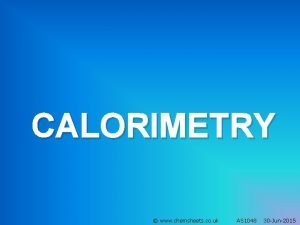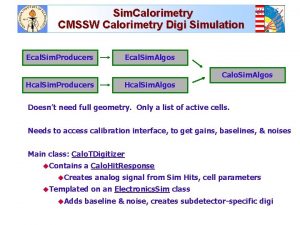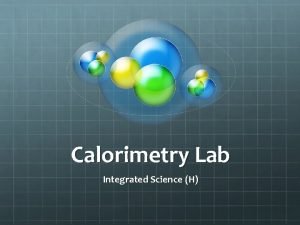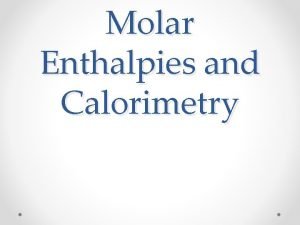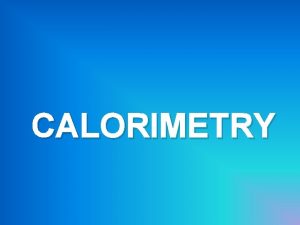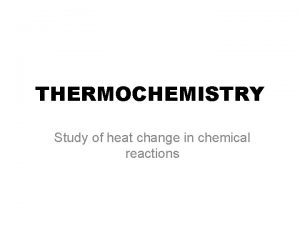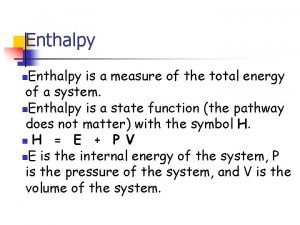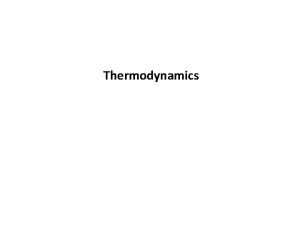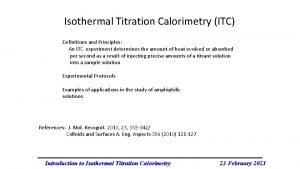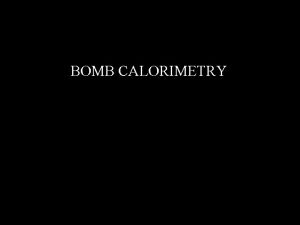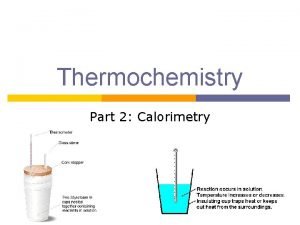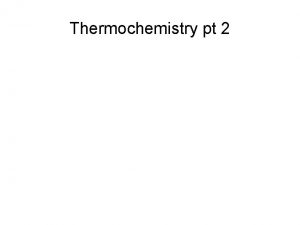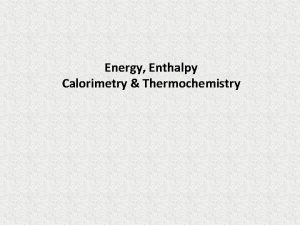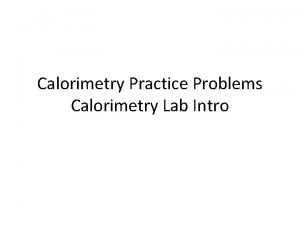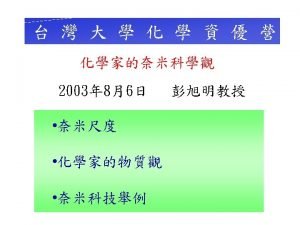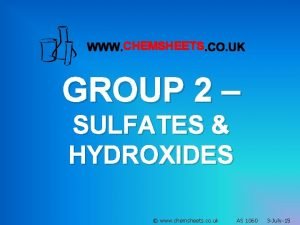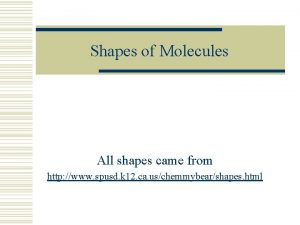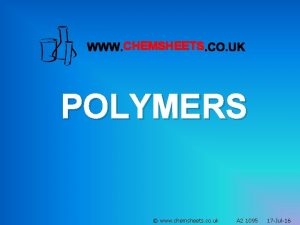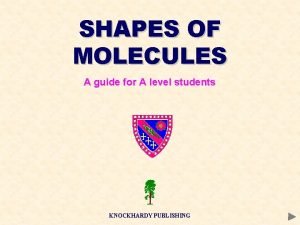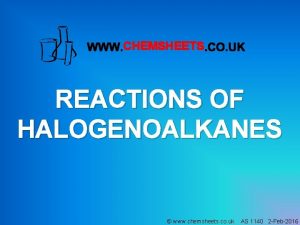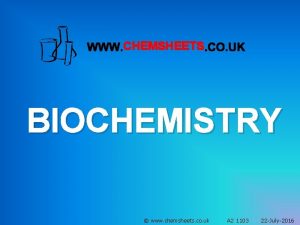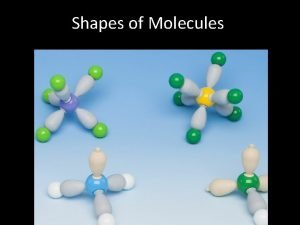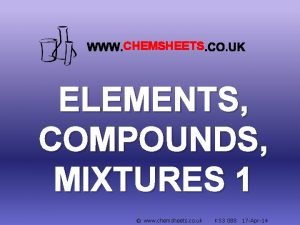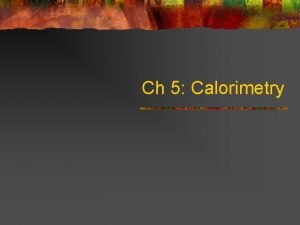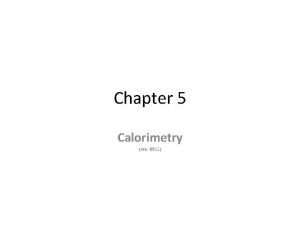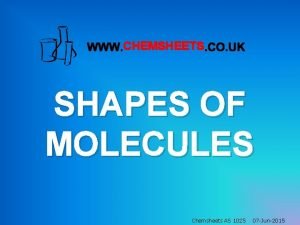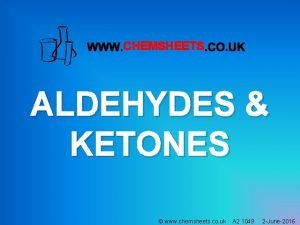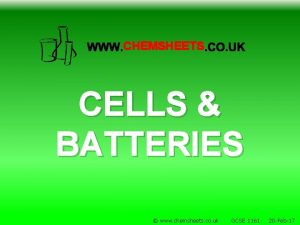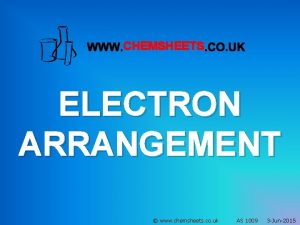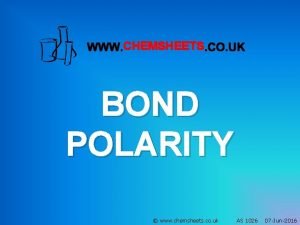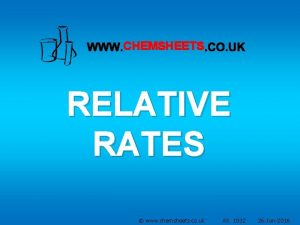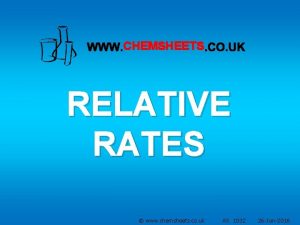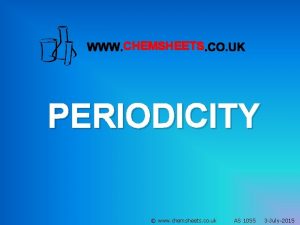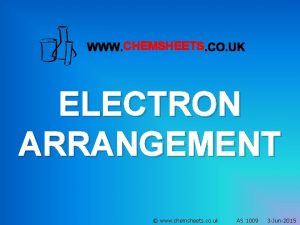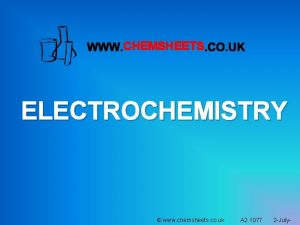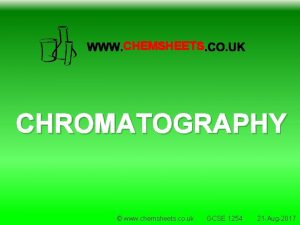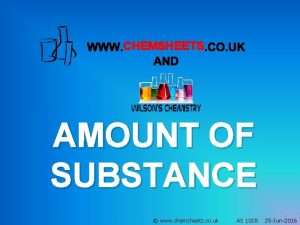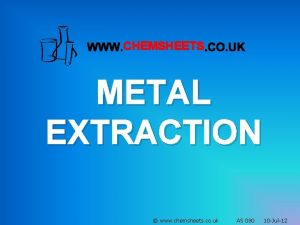CHEMSHEETS CALORIMETRY www chemsheets co uk AS 1048


























- Slides: 26

CHEMSHEETS CALORIMETRY © www. chemsheets. co. uk AS 1048 30 -Jun-2015

1 g of water 1 ºC hotter Energy required = 4. 18 J 1 g of water 2 ºC hotter Energy required = 2 x 4. 18 J = 8. 36 J © www. chemsheets. co. uk AS 1048 30 -Jun-2015

1 g of water 1 ºC hotter Energy required = 4. 18 J 5 g of water 1 ºC hotter Energy required = 5 x 4. 18 J = 20. 9 J © www. chemsheets. co. uk AS 1048 30 -Jun-2015

1 g of water 1 ºC hotter Energy required = 4. 18 J 3 g of water 10 ºC hotter Energy required = 3 x 10 x 4. 18 = 125. 4 J © www. chemsheets. co. uk AS 1048 30 -Jun-2015

1 g of copper 1 ºC hotter Energy required = 0. 39 J 10 g of copper 5 ºC hotter Energy required = 10 x 5 x 0. 39 = 19. 5 J © www. chemsheets. co. uk AS 1048 30 -Jun-2015

Energy required (q) = mass heated (m) x energy needed to make 1 g of substance 1ºC hotter x temperature rise (∆T) © www. chemsheets. co. uk AS 1048 30 -Jun-2015

Energy required (q) = mass heated (m) x specifc heat capacity (c) x temperature rise (∆T) © www. chemsheets. co. uk AS 1048 30 -Jun-2015

q = m c ∆T © www. chemsheets. co. uk AS 1048 30 -Jun-2015

2 moles of ethanol burned Energy given out = 2734 k. J Energy given out by 1 mole = 2734 k. J 2 = 1367 k. J -1 – 1367 k. J mol ∆H = © www. chemsheets. co. uk AS 1048 30 -Jun-2015

q ∆H = moles in reaction © www. chemsheets. co. uk AS 1048 30 -Jun-2015

© www. chemsheets. co. uk AS 1048 30 -Jun-2015

© www. chemsheets. co. uk AS 1048 30 -Jun-2015

1) In an experiment, 0. 600 g of propane (C 3 H 8) was completely burned in air. The heat evolved raised the temperature of 100 g of water by 64. 9 C. Use this data to calculate the enthalpy of combustion of propane (the specific heat capacity of water is 4. 18 J g-1 K-1). q = mc∆T m = 100 c = 4. 18 ∆T = 64. 9 q = 100 x 4. 18 x 64. 9 = 27130 J ∆H = q / moles of propane = mass / Mr = 0. 600 / 44. 0 = 0. 01364 ∆H = – 27. 13 / 0. 01364 = -1990 k. J mol-1 (3 sig fig) © www. chemsheets. co. uk AS 1048 30 -Jun-2015

2) 50 cm 3 of 1. 0 mol dm-3 hydrochloric acid was added to 50 cm 3 of 1. 0 mol dm-3 sodium hydroxide solution. The temperature rose by 6. 8 C. Calculate the enthalpy of neutralisation for this reaction. Assume that the density of the solution is 1. 00 g cm-3, the specific heat capacity of the solution is 4. 18 J g-1 K-1. q = mc∆T m = 100 c = 4. 18 ∆T = 6. 8 q = 100 x 4. 18 x 6. 8 = 2842 J ∆H = q / mol Mol HCl = conc x vol = 1. 0 x 50/1000 = 0. 050 Mol Na. OH = conc x vol = 1. 0 x 50/1000 = 0. 050 HCl + Na. OH → Na. Cl + H 2 O ∆H = – 2. 842 / 0. 050 = -57 k. J mol-1 (2 sig fig) © www. chemsheets. co. uk AS 1048 30 -Jun-2015

3) 100 cm 3 of 0. 200 mol dm-3 copper sulphate solution was put in a calorimeter and 2. 00 g of magnesium powder added. The temperature of the solution rose by 25. 1 C. Work out which reagent was in excess and then calculate the enthalpy change for the reaction. Assume that the density of the solution is 1. 00 g cm-3, the specific heat capacity of the solution is 4. 18 J g-1 K-1. Ignore the heat capacity of the metals. q = mc∆T m = 100 c = 4. 18 ∆T = 25. 1 q = 100 x 4. 18 x 25. 1 = 10490 J ∆H = q / mol Mol Cu. SO 4 = conc x vol = 0. 200 x 100/1000 = 0. 020 Mol Mg = mass / Mr = 2. 00 / 24. 3 = 0. 0823 XS Cu. SO 4 + Mg → Mg. SO 4 + Cu ∆H = – 10. 49 / 0. 020 = -525 k. J mol-1 (3 sig fig) © www. chemsheets. co. uk AS 1048 30 -Jun-2015

1) In an experiment, 1. 00 g of propanone (CH 3 COCH 3) was completely burned in air. The heat evolved raised the temperature of 150 g of water from 18. 8 C to 64. 3 C. Use this data to calculate the enthalpy of combustion of propanone (the specific heat capacity of water is 4. 18 J g 1 K-1). q = mc∆T m = 150 c = 4. 18 ∆T = 45. 5 q = 150 x 4. 18 x 45. 5 = 28530 J ∆H = q / moles of propane = mass / Mr = 1. 00 / 58. 0 = 0. 01724 ∆H = – 28. 53 / 0. 01724 = -1650 k. J mol-1 (3 sig fig) © www. chemsheets. co. uk AS 1048 30 -Jun-2015

2) In an experiment, 1. 00 g of hexane (C 6 H 14) was completely burned in air. The heat evolved raised the temperature of 200 g of water from 293. 5 K to 345. 1 K. Use this data to calculate the enthalpy of combustion of hexane (the specific heat capacity of water is 4. 18 J g-1 K-1). q = mc∆T m = 200 c = 4. 18 ∆T = 51. 6 q = 200 x 4. 18 x 51. 6 = 43140 J ∆H = q / moles of propane = mass / Mr = 1. 00 / 86. 0 = 0. 01163 ∆H = – 43. 14 / 0. 01163 = -3710 k. J mol-1 (3 sig fig) © www. chemsheets. co. uk AS 1048 30 -Jun-2015

3) In an experiment, 1. 56 g of propan-1 -ol (CH 3 CH 2 OH) was completely burned in air. The heat evolved raised the temperature of 0. 250 dm 3 of water from 292. 1 K to 339. 4 K. Use this data to calculate the enthalpy of combustion of propan-1 -ol (the specific heat capacity of water is 4. 18 J g -1 K-1). q = mc∆T m = 250 c = 4. 18 ∆T = 47. 3 q = 250 x 4. 18 x 47. 3 = 49430 J ∆H = q / moles of propane = mass / Mr = 1. 56 / 60. 0 = 0. 02600 ∆H = – 49. 43 / 0. 02600 = -1900 k. J mol-1 (3 sig fig) © www. chemsheets. co. uk AS 1048 30 -Jun-2015

4) 25 cm 3 of 2. 0 mol dm-3 nitric acid was added to 25 cm 3 of 2. 0 mol dm-3 potassium hydroxide solution. The temperature rose by 13. 7 C. Calculate the enthalpy of neutralisation for this reaction. Assume that the density of the solution is 1. 00 g cm-3, the specific heat capacity of the solution is 4. 18 J g-1 K-1. q = mc∆T m = 50 c = 4. 18 ∆T = 13. 7 q = 50 x 4. 18 x 13. 7 = 2863 J ∆H = q / mol Mol HNO 3 = conc x vol = 2. 0 x 25/1000 = 0. 050 Mol KOH = conc x vol = 2. 0 x 25/1000 = 0. 050 HNO 3 + KOH → Na. NO 3 + H 2 O ∆H = – 2. 863 / 0. 050 = -57. 3 k. J mol-1 (3 sig fig) © www. chemsheets. co. uk AS 1048 30 -Jun-2015

5) 50 cm 3 of 2. 0 mol dm-3 hydrochloric acid was added to 50 cm 3 of 2. 0 mol dm-3 ammonia solution. The temperature rose by 12. 4 C. Calculate the enthalpy of neutralisation for this reaction. Assume that the density of the solution is 1. 00 g cm-3, the specific heat capacity of the solution is 4. 18 J g-1 K-1. q = mc∆T m = 100 c = 4. 18 ∆T = 12. 4 q = 100 x 4. 18 x 12. 4 = 5183 J ∆H = q / mol Mol HCl = conc x vol = 2. 0 x 50/1000 = 0. 100 Mol NH 3 = conc x vol = 2. 0 x 50/1000 = 0. 100 HCl + NH 3 → NH 4 Cl ∆H = – 5. 183 / 0. 100 = -51. 8 k. J mol-1 (3 sig fig) © www. chemsheets. co. uk AS 1048 30 -Jun-2015

6) 50 cm 3 of 1. 0 mol dm-3 nitric acid was added to 20 cm 3 of 1. 0 mol dm-3 barium hydroxide solution. The temperature rose by 7. 9 C. Calculate the enthalpy of neutralisation for this reaction (per mole of nitric acid reacting). Assume that the density of the solution is 1. 00 g cm-3, the specific heat capacity of the solution is 4. 18 J g-1 K-1. q = mc∆T m = 70 c = 4. 18 ∆T = 7. 9 q = 70 x 4. 18 x 7. 9 = 2312 J ∆H = q / mol Mol HNO 3 = conc x vol = 1. 0 x 50/1000 = 0. 050 XS Mol Ba(OH)2 = conc x vol = 1. 0 x 20/1000 = 0. 020 2 HNO 3 + Ba(OH)2 → Ba(NO 3)2 + 2 H 2 O ∆H = – 2. 312 / 0. 040 = -57. 8 k. J mol-1 (3 sig fig) © www. chemsheets. co. uk AS 1048 30 -Jun-2015

7) 25 cm 3 of 1. 00 mol dm-3 copper sulphate solution was put in a calorimeter and 6. 0 g of zinc powder added. The temperature of the solution rose by 50. 6 C. Work out which reagent was in excess and then calculate the enthalpy change for the reaction. Assume that the density of the solution is 1. 00 g cm-3, the specific heat capacity of the solution is 4. 18 J g-1 K-1. Ignore the heat capacity of the metals. q = mc∆T m = 25 c = 4. 18 ∆T = 50. 6 q = 25 x 4. 18 x 50. 6 = 5288 J ∆H = q / mol Mol Cu. SO 4 = conc x vol = 1. 0 x 25/1000 = 0. 025 Mol Zn = mass / Mr = 6. 0 / 65. 4 = 0. 0917 XS Cu. SO 4 + Zn → Zn. SO 4 + Cu ∆H = – 5. 288 / 0. 025 = -212 k. J mol-1 (3 sig fig) © www. chemsheets. co. uk AS 1048 30 -Jun-2015

8) 50 cm 3 of 0. 10 mol dm-3 silver nitrate solution was put in a calorimeter and 0. 2 g of zinc powder added. The temperature of the solution rose by 4. 3 C. Work out which reagent was in excess and then calculate the enthalpy change for the reaction (per mole of zinc that reacts). Assume that the density of the solution is 1. 00 g cm-3, the specific heat capacity of the solution is 4. 18 J g-1 K-1. Ignore the heat capacity of the metals. q = mc∆T m = 50 c = 4. 18 ∆T = 4. 3 q = 50 x 4. 18 x 4. 3 = 898. 7 J ∆H = q / mol Mol Ag. NO 3 = conc x vol = 0. 1 x 50/1000 = 0. 005 Mol Zn = mass / Mr = 0. 2 / 65. 4 = 0. 00306 XS 2 Ag. NO 3 + Zn → Zn. NO 3 + 2 Ag ∆H = – 0. 8987 / 0. 0025 = -359 k. J mol-1 (3 sig fig) © www. chemsheets. co. uk AS 1048 30 -Jun-2015

9) 3. 53 g of sodium hydrogencarbonate was added to 30. 0 cm 3 of 2. 0 mol dm-3 hydrochloric acid. The temperature fell by 10. 3 K. Work out which reagent was in excess and then calculate the enthalpy change for the reaction. Assume that the density of the solution is 1. 00 g cm-3, the specific heat capacity of the solution is 4. 18 J g-1 K-1. q = mc∆T m = 30 c = 4. 18 ∆T = 10. 3 q = 30 x 4. 18 x 10. 3 = 1292 J ∆H = q / mol Mol HCl = conc x vol = 2. 0 x 30/1000 = 0. 060 XS Mol Na. HCO 3 = mass / Mr = 3. 53 / 84. 0 = 0. 0420 HCl + Na. HCO 3 → Na. Cl + H 2 O + CO 2 ∆H = 1. 292 / 0. 0420 = +30. 8 k. J mol-1 (3 sig fig) © www. chemsheets. co. uk AS 1048 30 -Jun-2015

10) A calorimeter was calibrated by burning 2. 00 g of methanol (CH 3 OH) whose enthalpy of combustion is -715 k. J mol-1. The temperature of the calorimeter rose from 19. 6 C to 52. 4 C. The same calorimeter was used to measure the enthalpy of combustion of propan-2 -ol. 1. 50 g of propan-2 -ol CH 3 CH(OH)CH 3 raised the temperature by from 19. 8 C to 56. 2 C. Calculate the heat capacity of the calorimeter and then the enthalpy of combustion of propan-2 -ol. ∆H = q / mol q = ∆H x mol Mol CH 3 OH = mass / Mr = 2. 00 / 32. 0 = 0. 0625 q = ∆H x mol = 715 x 0. 0625 = 44. 69 k. J q = mc∆T mc = q/∆T = 44. 69 / 32. 8 = 1. 363 k. J K-1 © www. chemsheets. co. uk AS 1048 30 -Jun-2015

10) A calorimeter was calibrated by burning 2. 00 g of methanol (CH 3 OH) whose enthalpy of combustion is -715 k. J mol-1. The temperature of the calorimeter rose from 19. 6 C to 52. 4 C. The same calorimeter was used to measure the enthalpy of combustion of propan-2 -ol. 1. 50 g of propan-2 -ol CH 3 CH(OH)CH 3 raised the temperature by from 19. 8 C to 56. 2 C. Calculate the heat capacity of the calorimeter and then the enthalpy of combustion of propan-2 -ol. q = mc∆T mc = 1. 363 ∆T = 36. 4 q = 1. 363 x 36. 4 = 49. 61 k. J ∆H = q / mol Mol C 3 H 7 OH = mass / Mr = 1. 50 / 60. 0 = 0. 0250 ∆H = – 49. 61 / 0. 0250 = -1984 k. J mol-1 (3 sig fig) © www. chemsheets. co. uk AS 1048 30 -Jun-2015
 Calorimetry 2 chemsheets answers 2015
Calorimetry 2 chemsheets answers 2015 Lei 1048/2000
Lei 1048/2000 Algoscalo
Algoscalo Food calorimetry simulation
Food calorimetry simulation Bomb calorimetry equation
Bomb calorimetry equation Calorimetry lesson
Calorimetry lesson Microscale combustion calorimetry
Microscale combustion calorimetry Q= mc∆t
Q= mc∆t Calorimetry formula
Calorimetry formula Qlost = qgained
Qlost = qgained Bomb calorimeter equation
Bomb calorimeter equation Isothermal titration calorimetry principle
Isothermal titration calorimetry principle Bomb calorimetry
Bomb calorimetry Bomb calorimeter
Bomb calorimeter Calorimetry
Calorimetry Thermochemistry calorimetry
Thermochemistry calorimetry Calorimetry practice problems
Calorimetry practice problems Chemsheets as 1052
Chemsheets as 1052 Chemsheets as 1063 answers
Chemsheets as 1063 answers Iof4- shape
Iof4- shape Addition polymers 2 chemsheets
Addition polymers 2 chemsheets Chemsheets shapes of molecules answers
Chemsheets shapes of molecules answers Chemsheets reactions of halogenoalkanes 2
Chemsheets reactions of halogenoalkanes 2 Chemsheets as 1052
Chemsheets as 1052 Chemsheets amino acids
Chemsheets amino acids Chemsheets shapes of molecules
Chemsheets shapes of molecules Chemsheets
Chemsheets
